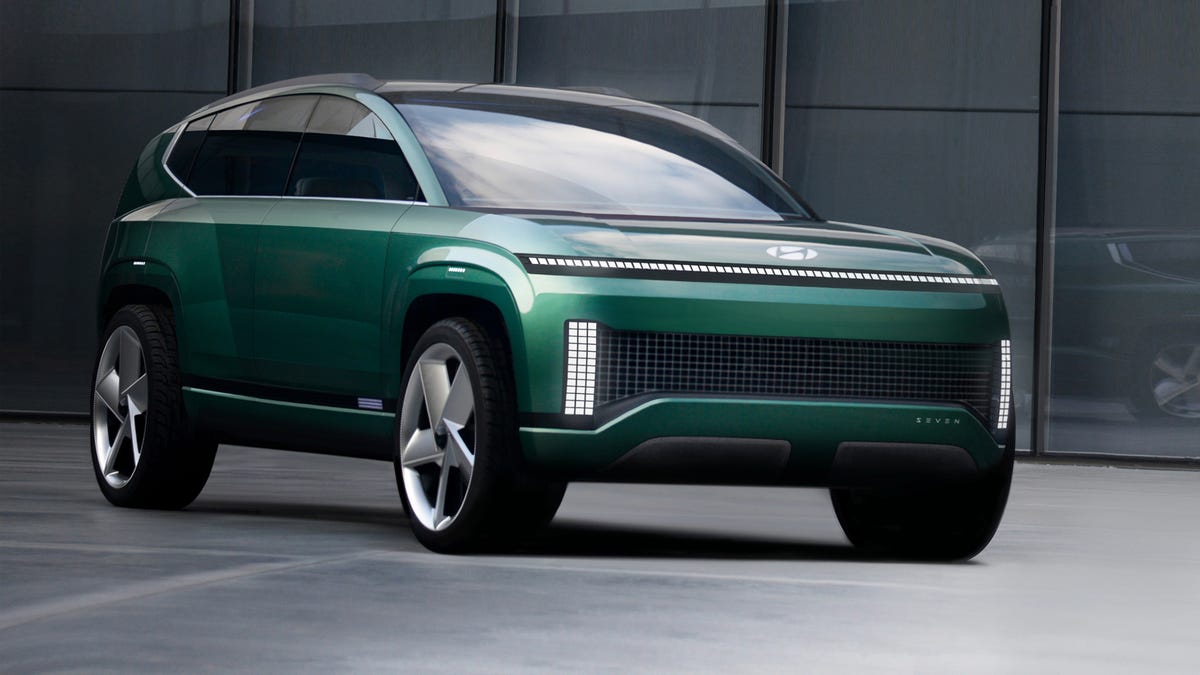Hyundai Seven concept SUV rocks the block with retrofuturistic style, EV power
Minus the funky doors, you can expect to see a production version of this three-row electric SUV in dealers eventually.
Hyundai's push into EVs has resulted in some of the coolest concept cars we've seen in years, whether it's the sharply angled 45 (a showcar that eventually birthed the Ioniq 5) or the smoothed-over Prophecy. Now, the Korean automaker has rolled into the 2021 LA Auto Show with something equally cool and equally electric, but much larger.
This Seven three-row electric crossover concept is a genuine three-row SUV despite sharing its E-GMP dedicated electric-vehicle platform with the much-smaller Hyundai Ioniq 5, Kia EV6 and Genesis GV60. That's one of the best things about a scalable platform -- it can expand or contract as needed to accommodate vehicles of all shapes and sizes.
The Seven's wheelbase measures an impressive 10.5 feet, about the same as a Mercedes-Benz S-Class . From a design standpoint, Hyundai hasn't just modeled the Seven after today's Palisade . Instead, a unique mixture of smooth and hard edges creates a fresh silhouette that looks futuristic as hell, especially out back, where the rear end is almost entirely glass. At the same time, the look is somehow pleasingly 8-bit, thanks to its sharp corners and box-element LED lighting. Even the wheels are interesting; they come equipped with active flaps that can open and close to either cool the brakes or improve the car's aerodynamics.
And then there's the interior, which more closely resembles a salon than a car. A bench seat sweeps around from the rear to the side, while individual chairs make use of the concept's uncluttered space to pivot around and slide back and forth. Pillarless suicide doors create a massive side opening for ingress and egress. Since it was built with conditional autonomy in mind, the vehicle controls are retractable, and screens cover almost the entire front end. Hell, even the roof has a panoramic OLED display. There's also a built-in mini fridge, because why not?
Hyundai focused on sustainability when creating the Seven concept's interior. Renewable and recycled materials like bamboo comprise most of the surfaces inside, while copper trim and fabric treated with antibacterial coatings provides some hygienic peace of mind. When everyone gets out of the vehicle, UVC lights can sterilize the whole shebang.
That is one welcoming cabin.
While it's merely a concept for now, company officials are telegraphing that a production version of the Seven will be among the next vehicles to join Hyundai's growing Ioniq electric sub-brand. As such, the automaker did give out a few performance specs that may hint at where the eventual production model could land. The Korean automaker claims the Seven concept can use 350-kilowatt charging to bring its battery from 10% capacity to 80% in about 20 minutes, with a target range of "over 300 miles."
There's always going to be quite the gulf between any concept car and the production model it may eventually come to preview. But, based on the work Hyundai has done here, it seems like it won't be too long before we see something more production minded. We wouldn't necessarily expect the production model to wear the concept's reverse-hinged rear doors and pillarless construction, nor boast its fold-away controls or glass-heavy tailgate. That said, we're still going to hold out hope that the Seven's sweet, curved bench seat survives the adaptation. We can dream, can't we?


